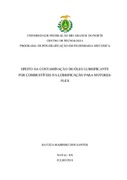Use este identificador para citar ou linkar para este item:
https://repositorio.ufrn.br/handle/123456789/25966| Título: | Efeito da contaminação do óleo lubrificante por combustíveis na lubrificação para motores-flex |
| Título(s) alternativo(s): | Effect of presence of gasoline and ethanol on lubrication of flexMotors |
| Autor(es): | Santos, Rayzza Marinho dos |
| Orientador: | Alves, Salete Martins |
| Palavras-chave: | Motores-flex;Etanol;Gasolina;Lubrificantes |
| Data do documento: | 26-Jul-2018 |
| Referência: | SANTOS, Rayzza Marinho dos. Efeito da contaminação do óleo lubrificante por combustíveis na lubrificação para motores-flex. 2018. 91f. Dissertação (Mestrado em Engenharia Mecânica) - Centro de Tecnologia, Universidade Federal do Rio Grande do Norte, Natal, 2018. |
| Resumo: | Motores que permitem a utilização de qualquer porcentagem de álcool e gasolina como combustível são conhecidos como motores flex. Estes enfrentam grandes desafios tribológicos que parecem estar associados a uma lubrificação inadequada e a um severo desgaste triboquímico. A otimização dos motores flex-fuel tornou-se um urgente desafio tecnológico no momento em que o etanol veicular se afirma, cada vez mais, como alternativa para a redução das emissões de CO2 e outros poluentes. O presente trabalho objetivou contribuir para um melhor entendimento dos fenômenos de lubrificação, atrito e desgaste em motores-flex. Para tanto, foram analisados os efeitos da adição de porcentagens de combustíveis (etanol e gasolina comum) ao óleo sintético, no desempenho tribológico destes lubrificantes. Efetuouse a preparação dos lubrificantes a partir do óleo sintético, com contaminação de 1, 2 e 5% do combustível, em peso. Sabendo que o contato entre as peças do motor onde o lubrificante atua se dá por deslizamento, utilizou-se o equipamento HFRR (High Frequency Reciprocating Rig) a fim de mensurar a capacidade de lubrificação, ou seja, a capacidade de um fluido reduzir o atrito e o desgaste entre as superfícies em movimento relativo sob carga. Com base nisto, foram avaliados no decorrer do ensaio: coeficiente de atrito (COF) e percentual de formação de filme, além da realização da caracterização do desgaste através de análises de MEV/EDS. Os resultados mostraram que a contaminação do lubrificante com os combustíveis estudados diminuiu sua capacidade de lubrificação. Este efeito foi mais acentuado para maiores proporções de etanol. Em seguida os lubrificantes contaminados foram analisados por FTIR (Fourier Transform Infrared) e Fluorescência de Raios-X verificando que não houve degradação do óleo, mas o aumento de partículas como ferro e a diminuição de zinco, cálcio e fósforo, contribuiu para um mau desempenho na redução do atrito e desgaste. Os resultados mostraram que a contaminação do lubrificante com os combustíveis estudados diminuiu sua capacidade de lubrificação. Este efeito foi mais acentuado para maiores proporções de etanol. |
| Abstract: | Engines that use alcohol and gasoline as fuel are known as flexible fuel engines, they have a great tribological challenge, which is related to no suitable lubrication and severe tribochemical wear. Thus an optimization of flex-fuel engines has become an urgent technological challenge as vehicular ethanol increasingly asserts itself as an alternative to reducing CO2 and other pollutants. The present work aimed to contribute to a better understanding of the lubrication phenomena, friction and wear in flex-fuels engines. For that, the effects of the addition of fuels percentages (ethanol and common gasoline) to the synthetic oil on the tribological performance of the lubricants were analyzed. The lubricants were prepared from synthetic oil, with 1, 2 and 5% of the fuel by weight. Knowing what that the contact with engine parts or hydraulic equipment is by sliding, the tribometer HFRR (High Frequency Equipment) was used to measure the lubricating capacity, or the ability of a fluid to reduce wear and tear between surfaces relative movement under load. Based on this: during the tribologial tests coefficient of friction (COF) and percentage of film formation were measured. At the end of the test a wear characterization was performed through MEV/EDS analysis. The results showed that the contamination of the lubricant with the studied fuels decreased its lubrication capacity. This effect is more pronounced for larger proportions of ethanol. Then the lubricants were analyzed by FTIR (Infrared Spectroscopy with Fourier Transform) and X-Ray Fluorescence without verification of the oil degradation, but with the increase of iron and the decrease of zinc, calcium and phosphorus, contribution for performance in reducing friction and wear. |
| URI: | https://repositorio.ufrn.br/jspui/handle/123456789/25966 |
| Aparece nas coleções: | PPGEM - Mestrado em Engenharia Mecânica |
Arquivos associados a este item:
| Arquivo | Descrição | Tamanho | Formato | |
|---|---|---|---|---|
| Efeitocontaminaçãóleo_Santos_2018.pdf | 3,45 MB | Adobe PDF |  Visualizar/Abrir |
Os itens no repositório estão protegidos por copyright, com todos os direitos reservados, salvo quando é indicado o contrário.

